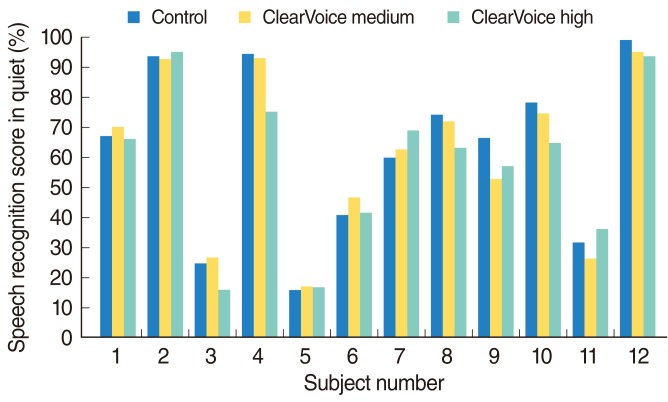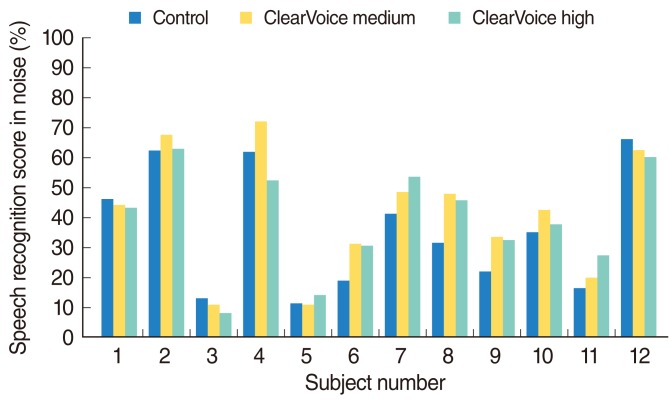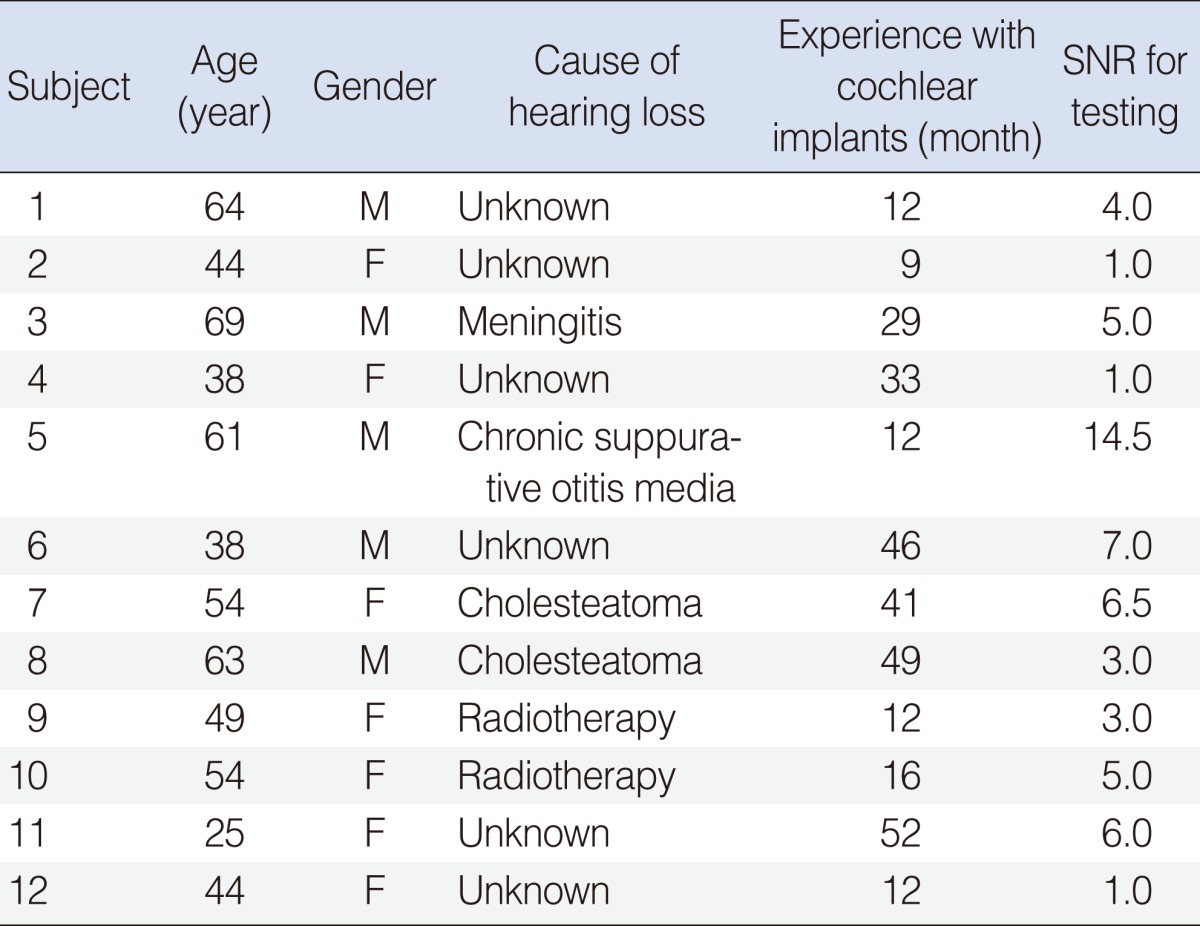INTRODUCTION
Cochlear implant users often have difficulty in speech perception in noisy listening situations (1-3). Possible means to improve the ability to understand speech in noise include utilization of multi-microphone technology and coupling the sound processor to a frequency modulation system. These methods have been shown to be effective in improving speech recognition in noise in cochlear implant users (2-6), but the incorporation of a noise reduction algorithm as a preprocessor to the cochlear implant speech processor may be a more convenient and cost saving strategy (7).
The ClearVoice strategy, developed by Advanced Bionics (Valencia, CA, USA), uses a digital signal analysis algorithm to analyze the incoming signal into different frequency channels and to estimate the respective noise level or signal-to-noise (SNR) level. The gain for channels, in which noise is being detected or with lower SNR, is reduced. This leads to an emphasis of more dynamic channels which are more likely to contain speech signals and hence improve overall SNR. Results obtained in Europe showed improvement in speech recognition in noise in a group of 13 experienced HiRes 120 users immediately with ClearVoice activated (7). The aim of the study reported herein was to evaluate the objective and subjective benefits of and level of satisfaction with the ClearVoice strategy in adult Chinese HiRes 120 cochlear implant users.
MATERIALS AND METHODS
Subjects
Twelve adults (five males and seven females) using the Harmony processor and HiRes 120 sound processing participated in the study. Subjects were recruited in the Prince of Wales Hospital. The age of the subjects ranged from 25.2 to 69.2 years, with a mean age of 50.3 years. Duration of implant and HiRes 120 sound processing use ranged from 0.7 to 4.0 years, with a mean of 1.9 years. All subjects were native Cantonese speakers and unilateral implant users. Table 1 summarizes the subjects' hearing manifestation and history. Informed consent was obtained from the subjects, and the principles outlined in the Declaration of Helsinki were followed. Local research ethics approval was granted for the study.
Procedures
The subjects attended two sessions (initial and one-week follow-up), each lasted for about two hours. All of the audiological testing was carried out in a sound booth at the Audiology Centre of the Prince of Wales Hospital.
In the initial session, the appropriate SNR for speech perception testing in noise was established with the subjects' own HiRes 120 program (control program). Speech perception in quiet was first tested by the Cantonese Hearing in Noise Test (CHINT) (8) with the control program. CHINT sentences were presented at 65 dB HL at zero azimuth. Testing in quiet was performed to identify the "target" score in noise which was defined as the score that is approximately 50% of the score in quiet but no less than 30% correct. Then speech perception in noise was assessed with the control program at the default volume setting. CHINT sentences and speech spectral noise were both presented at zero degree azimuth. The speech spectral noise was presented at 70 dB HL while the signal level was adjusted until the speech perception score matched with the "target" score in noise (i.e., about half of the speech perception score in quiet, but no less than 30% correct). The SNR at which the "target" score in noise was obtained, was used for all subsequent testing in noise in the follow-up session. The ClearVoice strategy was then activated in the Harmony processor in two new separate programs: one with gain settings of -12 dB (ClearVoice medium) and the other with gain settings of -18 dB (ClearVoice high). No adjustment was made in the control program and the only difference among the three programs was the setting of ClearVoice. The subjects were asked to try out the three available programs (control, ClearVoice medium, and ClearVoice high) in different everyday listening situations in the following week.
In the follow-up session, speech perception testing was conducted both in quiet and in noise with all the three available programs. The order of testing with the control and two ClearVoice programs were counterbalanced across subjects. The subjects were blinded to the program that was being tested. The same test equipment, materials and settings as those employed in the initial session were used during these tests. Speech perception score in noise was measured at the designated SNR which has been obtained in the initial session. All tests were performed with the default volume setting. The subjects were then asked to fill in a questionnaire and indicate their preference and strength of preference for ClearVoice, as well as indicate the listening conditions under which the ClearVoice options provided noticeable benefit.
RESULTS
Speech test results
Speech recognition performance was assessed with the CHINT. The individual scores in quiet and in noise for all 12 subjects are shown in Figs. 1 and 2 respectively. The SNR used in testing in noise for individual subjects are listed in Table 1. The average percent correct in quiet was 62.1% (SD, 28.3), 60.67% (SD, 27.3), and 57.7% (SD, 26.0) for the control, ClearVoice medium and ClearVoice high program, respectively. Paired samples t-test revealed no significant difference in the speech recognition score in quiet among the three listening programs. The average percent correct in noise was 35.5% (SD, 20.0), 41.0% (SD, 20.5), and 38.9% (SD, 17.3) for the control, ClearVoice medium and ClearVoice high program, respectively. Paired samples t-test revealed that speech perception in noise was significantly better with ClearVoice medium program than with the control program (t=-2.9, P<0.05). No statistically significant difference was observed in speech perception in noise between ClearVoice medium and Clear Voice high or between ClearVoice high and control program. The mean speech recognition scores obtained in quiet and in noise with the three tested programs are shown in Fig. 3.
Subjective preference
All subjects preferred the ClearVoice programs. Half of the subjects preferred the ClearVoice medium and half of the subjects preferred the ClearVoice high program. The subjects were asked to rate the strength of their preference on the preferred program on a 10-point scale (1, very weak preference; 10, very strong preference). The average rating on strength of preference was 7.9. Distribution of the strength of preference for the preferred programs is depicted in Fig. 4. One-third of the subjects would like to use the ClearVoice programs all of the time and the remaining two-third of the subjects would like to use the ClearVoice programs most of the time. No subject preferred the control program or would like to turn the ClearVoice off.
Situational preference
Most of the subjects found ClearVoice useful in the following situations: conversing in a group of people (83%), conversing in a car (75%), conversing in a party or restaurant (75%), and using a telephone or cell phone (75%). Some of the subjects found ClearVoice useful in watching TV or listening to talk radio (50%), listening in a meeting (50%), listening to a public speaker in a church or auditorium (42%), and understanding of words in songs (42%). The percentage distributions on ratings on situational preference are shown in Fig. 5. The subjects were asked to rate the usefulness of ClearVoice in some listening situations on a 7-point scale (1, strongly disagree; 7, strongly agree). On average, the subjects agreed that the ClearVoice makes listening in challenging situations easier, less tiring or stressful, and more enjoyable. Distribution of average ratings on the usefulness of ClearVoice is depicted in Fig. 6.
DISCUSSION
The objective and subjective benefits of and the level of satisfaction with ClearVoice strategy was evaluated in this study. Mean speech recognition scores in quiet were not significantly different among the three programs tested. These results were expected as the three programs should provide essentially the same signal processing and gain modification in quiet. Mean speech recognition scores in noise for the ClearVoice medium program was significantly better than those for the control program but not significantly different from those for the ClearVoice high program. This shows that the ClearVoice strategy with maximum gain reduction of 12 dB in the channels with noise detected was effective in improving speech perception in noise, however the higher maximum gain reduction of 18 dB did not further improve the performance in the present experimental setting.
Only one type of noise (speech spectral noise) at one presentation level was being used in testing in noise in this study. At a higher noise level, the higher reduction in gain might bring additional benefit in speech recognition in noise. Half of the subjects in this study preferred the ClearVoice high program after one week of real life trial and no subject complained about the audibility or overall loudness of the program. The subjects might have adjusted the processor volume in real life situations. All testing were done at the default volume setting of the subjects' own processor in this study. Speech perception in noise with ClearVoice might be affected if the subjects were allowed to adjust the volume of their processors. These speculations have to be tested in further study.
In concordance with data from a European investigation (7), the present study demonstrated that ClearVoice is effective in enhancing speech perception in noise. All subjects preferred the ClearVoice programs and no subject would like to turn ClearVoice off. In view of the individual variations in performance observed, prescription of multiple programs with ClearVoice at different gain settings is recommended.
















